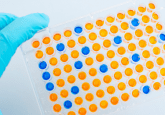Study highlights the potential adverse effects of nanoparticles on the liver

A study conducted by researchers from Cornell University (NY, USA) has revealed that liver tissue injury occurs at lower nanoparticle concentrations than originally expected.
The team used a microfluidic detection device that is capable of recreating interactions between the GI tract and the liver to give a more realistic assessment of nanoparticle toxicity. The microfluidic silicon chips were created with separate chambers containing different tissue analogs in the form of cell cultures, to produce a body-on-a-chip device that essentially acts as a miniaturized model of a section of the human body.
Carboxylated polystyrene nanoparticles were then fluorescently labeled so their movement between the chambers could be tracked, and levels of aspartate transaminase, a cytosolic enzyme released into the culture medium upon cell death, were measured to give an indication of liver damage.
The team, which was led by Michael Shuler, observed that single nanoparticles and smaller nanoparticle aggregates were able to cross the GI barrier and reach the liver cells. As these nanoparticles have increased zeta potentials, the group inferred that they will most likely raise toxic potential by crossing the barrier. Larger nanoparticles, on the other hand, which interact with cell membranes and aggregate into clusters, were found to have been blocked much more effectively by the GI tract barrier.
According to the team, the study highlights the importance of body-on-a-chip devices as highly relevant in vitro models for evaluating nanoparticle interactions with human tissues. In terms of future work, the group now intends to use 3D constructs of tissues in order to make the simulations more realistic and allow for more authentic physiological behavior to be observed.
Source: Esch MB, Mahler GJ, Stokol T. Body-on-a-chip simulation with gastrointestinal tract and liver tissues suggests that ingested nanoparticles have the potential to cause liver injury. Lab Chip DOI:10.1039/C4LC00371C (2014) (Epub ahead of print).






